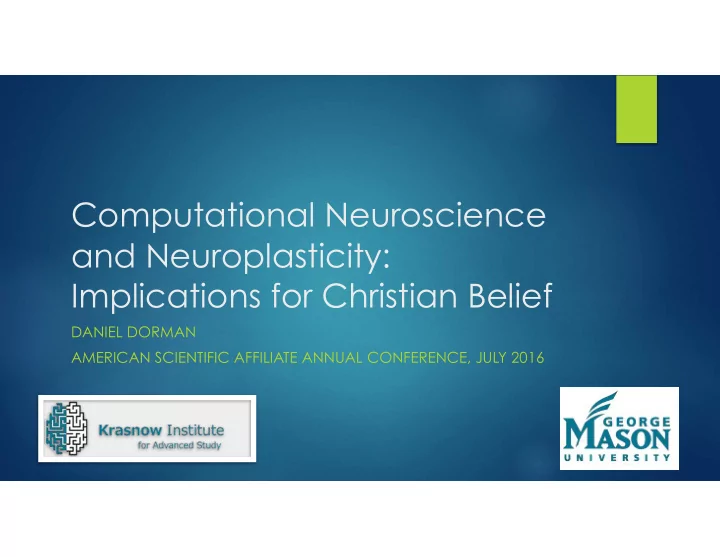

Computational Neuroscience and Neuroplasticity: Implications for Christian Belief DANIEL DORMAN AMERICAN SCIENTIFIC AFFILIATE ANNUAL CONFERENCE, JULY 2016
Big Questions “Our human intelligence is based on computational processes that we are learning to understand. We will ultimately multiply our intellectual powers by applying and extending the methods of human intelligence using the vastly greater capacity of nonbiological computation.” ― Ray Kurzweil , The Singularity is Near: When Humans Transcend Biology
Big Questions “’Can a computational simulation of a brain suffer?’. If the answer is ‘yes’, it then follows that we should consider extending the same protections against suffering that are given to subjects of experimental research.” (Bancroft, Ethical Aspects of Computational Neuroscience, Neuroethics , 2013)
Big Questions “Here is an idea that would make Descartes blanch. Apparently, there are scientists who believe that at some point fairly soon we will be able to upload our minds to computers, freeing ourselves from our bodies, being, therefore, immortal. I suppose they will program in the virtual experience of taking the uploaded dog on a walk to the virtual park, through the rain on randomly assorted virtual days adjusted to reflect prevailing weather patterns in some selected place and season. These immortals would at last be free of the thousand natural shocks that flesh is heir to, and with them no doubt of all urgent reflection on what we are and what we mean. I can’t help imagining that, given the sterility of it all, the sullens would set in and these uploaded minds would do what many of their creators do—devise ingenious viruses, spy on one another, refine resentments, contrive schemes to dupe the mortals. Then physical reality, let us say a great solar storm, the impact of a meteor, even a major war, would sweep them all away, making the always necessary point that, for our purposes, the physical is not to be transcended. In any case, an uploaded mind would be as void of soul as a cryogenically frozen body. We know this intuitively.”
� Is such a vision… � theoretically possible, grounded in current progress in the field of computational neuroscience? � Desirable from a Christian and Humanist perspective?
Outline � Conceptual Foundations for Computational Neuroscience � Current progress and perspectives in the field � My work: Computational Neuroplasticity � Framework for Understanding Computation Neuroscience
Conceptual Foundations Computational Description and Prediction Computational Neurons/Brains Theory of Mind Compute
Progress and Perspectives – A Comparison of Two Approaches Top Down, Functional Approach - Bottom up, biological approach – The SPAUN Blue Brain Project
SPAUN – A Behaving Brain Simulation � 2.5 Million Neuron Brain Model � Approximates known brain circuits � Sensing eye � Robotic Arm � Engineered to perform specific functions Eliasmith, Chris, et al. "A large-scale model of the functioning brain." Science 338.6111 (2012): 1202-1205.
Blue Brain Project – Biologically Driven Cortical Column Model Experimental • Reconstruction Detailed model • Emergent • neural activity patterns Markram et al. Reconstruction and Simulation of Neocortical Microcircuitry. Cell 2015;163(2):456-492.
Summary of Contrasting Models
My Research: Single Cell Models and Subcellular Mechanisms of Synaptic Plasticity http://www.genesis-sim.org/GENESIS/Tutorials/cnslecs/cns2a.html Kotaleski & Blackwell, 2010
Computational Neuroplasticity Phenomenon – Neuroplasticity of Striatum Implications Experimental wikimedia Computational Data Model Predictions
The striatum is the input nucleus to the basal ganglia and is associated with reward-driven action and learning � Cognitive associations Action selection • Goal-directed & • reinforcement learning Habit formation • Scholarpedia.org Kravitz and Kreitzer, 2012 How does a single striatal neuron participate in learning and action? 16
Supralinear Response to Cooperative Synaptic Input
Presynaptic Activity Patterns Trigger Biochemical Signalling Pathways that Alter the Physiology and Structure of the Neuron and Modify Genetic Expression at the Nucleus Bhalla US. Molecular computation in neurons: a modeling perspective. Curr. Opin. Neurobiol. 2014
Interpretive Framework Embodied Genetic Network Action Cellular Expression Activity Activity Situated in Environment
Level 1 computational methods enable description and explanation of how the � physical substrate of the brain may be said to compute, to process neural information (level 2). Does this then support level 3, that (a) the mind is strictly computational, in an abstracted sense that makes the brain accidental, such that any computing substrate could have a mind, or (b) such that level 1 computational simulations could possess an internal, subjective, conscious self? I argue that neuroscience challenges level 3, because in the brain, information and � computation are physically, neuronally, embodied, whereas in a simulation there are multiple levels of abstraction: We describe physical neurons in abstract mathematical terms, and we then translate the mathematical equations to computer algorithms which yield numbers; it is only our understanding and interpretation of those numbers that render the results meaningful, the computer could care less. However, new physical conceptions of computers are being designed to parallel the � biology of the brain. If brain simulations can be physically embodied in such computers, without abstraction, we may be surprised.
SPAUN – A Behaving Brain Simulation � 1. Eliasmith C, Trujillo O. The use and abuse of large-scale brain models. Curr. Opin. Neurobiol. 2014;25:1-6. doi:10.1016/j.conb. 2013.09.009.
� 1. Kaplan DM. Explanation and description in computational neuroscience. Synthese 2011;183(3):339-373. doi:10.1007/ s11229-011-9970-0.
� 1. Piccinini G, Shagrir O. Foundations of computational neuroscience. Curr. Opin. Neurobiol. 2014;25:25-30. doi:10.1016/ j.conb.2013.10.005.
� 1. Critical Neuroscience .
� 1. Markram H, Muller E, Ramaswamy S, et al. Reconstruction and Simulation of Neocortical Microcircuitry. Cell 2015;163(2):456-492. doi: 10.1016/j.cell.2015.09.029.
Recommend
More recommend